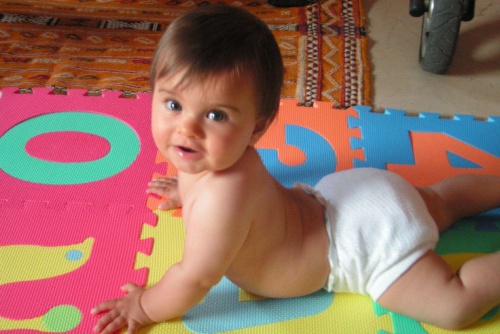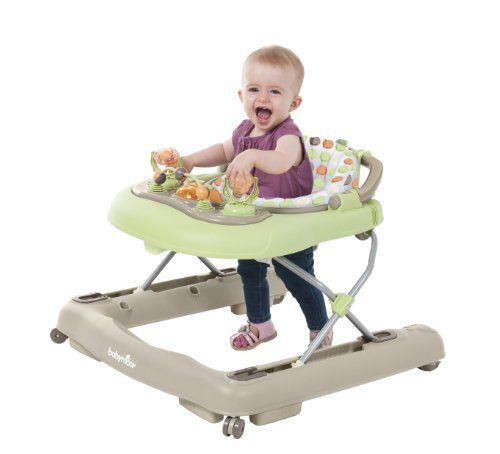Walkers, Enemies of Babies' First Steps?

Many of us started learning how to walk with the help of baby walkers. That’s why our mothers or mothers-in-law, now grandmothers, insist that we use them to help our children take their first steps.
However, pediatricians don’t recommend using walkers. Why is this device not good for babies?
Walkers are not only ineffective when it comes to teaching babies how to walk, but also alter their natural neurological and motor development.
They also represent an imminent danger to children at home, according to studies conducted over the last few years.
Neurological and evolutionary perspective
Walkers are questioned by neurologists and specialists in evolutionary psychology. Walkers interfere with the activity of crawling.
Crawling is fundamental for every child’s evolutionary development since it connects the cerebral hemispheres. It also creates crucial information routes for the maturation of different cognitive functions.
According to experts, crawling allows children to coordinate opposing movements. This recreates the crossed pattern, a neurological function that allows a corporal displacement in balance.
When the baby alternates the left leg with the right, and the right arm with the left, it promotes an integrated brain state.
In addition, the movement of crawling – skipped over by the use of a walker – tones the muscles that will then allow the child to keep the spine straight.
It also exercises the focus of the eyes. When looking at the ground to distinguish where their hand or knee is, the little one stares at a close point.
Likewise, when the baby rests on the palms of their hands and supports themselves using their shoulder and wrist joints, they perceive gravity and learn to deal with it.
This helps them to measure the world and allows for a “lateralization” of the brain, where one of the hemispheres dominates and the other serves.

Walkers, in the eyes of orthopedic surgeons
According to specialists in this field, walkers alter the natural development of both legs and back as they force certain postures and movements.
Using a walker not only requires learning to walk with the legs apart but also involves abnormalities in knee and feet positions and movement.
In addition, arching the legs inevitably affects the development of the back. At that age, the back is not prepared to keep the child upright when they still have no strength to stand.
Trauma specialists also say that it deforms the arches of the legs.
Walkers also force children to remain on the tips of their feet. This is an abnormal position that is usually maintained for a while when using walkers.
This shows that babies are not prepared at the motor skills level to handle balance, height, and distance calculation issues with the use of a walker.
Walkers don’t teach babies how to walk
As specialists point out, babies first learn to sit, then crawl, and then start to stand and walk. This process is linked to mental development that should not be forced because each child has its own rhythm.
Therefore, placing the baby in a walker when they still don’t know how to walk distances their mind from the movement. What their legs can do coordinates with their mental development.
It doesn’t allow them to incorporate spatial notions of their own body with respect to the environment: they don’t see their feet moving.
Several scientific studies, including the one published in the British Medical Journal, conclude that the use of a walker delays the start of walking as well as impairs motor skills and cognitive development of the child.

And what about the accidents in the walker?
Specialists discourage the use of walkers, as they cause a four-time increase in the number of serious accidents. According to figures provided by the Society of Pediatrics in Argentina, about 45% of children who use a walker, suffer an accident during use.
It is a fact: the wheels and the little control that babies have can cause accidents of all kinds.
Children who use a walker have a double risk of suffering a hit to the head than those who do not use it. Children using a walker also have twice as many chances of fractures of the arms and legs.
These probabilities also increase by four when it comes to falling down stairs, increased exposure to burns, puncture wounds, asphyxiation and even death due to the walker.
How serious can it be?
While in some countries such as Brazil or Canada, baby walkers are totally forbidden, in other places they are still being sold and used. However, pediatricians and specialists in health fields discourage walkers because of the multiple disadvantages.
Some people may think that the scientific observations are exaggerated, especially if their child uses a walker or if they appreciate the fact that several generations grew up on those chairs with wheels.
They may say things like “I love it,” “nothing happened to my child” and “I learned to walk fast.”
Of course, if the walker is used with moderation, control and extreme care, accidents can be prevented.
But there are still some problems that put the health, welfare, and development of your child at risk, when it is a totally non-essential item.
Ultimately, the decision is up to the parents, walker yes or walker no?
Many of us started learning how to walk with the help of baby walkers. That’s why our mothers or mothers-in-law, now grandmothers, insist that we use them to help our children take their first steps.
However, pediatricians don’t recommend using walkers. Why is this device not good for babies?
Walkers are not only ineffective when it comes to teaching babies how to walk, but also alter their natural neurological and motor development.
They also represent an imminent danger to children at home, according to studies conducted over the last few years.
Neurological and evolutionary perspective
Walkers are questioned by neurologists and specialists in evolutionary psychology. Walkers interfere with the activity of crawling.
Crawling is fundamental for every child’s evolutionary development since it connects the cerebral hemispheres. It also creates crucial information routes for the maturation of different cognitive functions.
According to experts, crawling allows children to coordinate opposing movements. This recreates the crossed pattern, a neurological function that allows a corporal displacement in balance.
When the baby alternates the left leg with the right, and the right arm with the left, it promotes an integrated brain state.
In addition, the movement of crawling – skipped over by the use of a walker – tones the muscles that will then allow the child to keep the spine straight.
It also exercises the focus of the eyes. When looking at the ground to distinguish where their hand or knee is, the little one stares at a close point.
Likewise, when the baby rests on the palms of their hands and supports themselves using their shoulder and wrist joints, they perceive gravity and learn to deal with it.
This helps them to measure the world and allows for a “lateralization” of the brain, where one of the hemispheres dominates and the other serves.

Walkers, in the eyes of orthopedic surgeons
According to specialists in this field, walkers alter the natural development of both legs and back as they force certain postures and movements.
Using a walker not only requires learning to walk with the legs apart but also involves abnormalities in knee and feet positions and movement.
In addition, arching the legs inevitably affects the development of the back. At that age, the back is not prepared to keep the child upright when they still have no strength to stand.
Trauma specialists also say that it deforms the arches of the legs.
Walkers also force children to remain on the tips of their feet. This is an abnormal position that is usually maintained for a while when using walkers.
This shows that babies are not prepared at the motor skills level to handle balance, height, and distance calculation issues with the use of a walker.
Walkers don’t teach babies how to walk
As specialists point out, babies first learn to sit, then crawl, and then start to stand and walk. This process is linked to mental development that should not be forced because each child has its own rhythm.
Therefore, placing the baby in a walker when they still don’t know how to walk distances their mind from the movement. What their legs can do coordinates with their mental development.
It doesn’t allow them to incorporate spatial notions of their own body with respect to the environment: they don’t see their feet moving.
Several scientific studies, including the one published in the British Medical Journal, conclude that the use of a walker delays the start of walking as well as impairs motor skills and cognitive development of the child.

And what about the accidents in the walker?
Specialists discourage the use of walkers, as they cause a four-time increase in the number of serious accidents. According to figures provided by the Society of Pediatrics in Argentina, about 45% of children who use a walker, suffer an accident during use.
It is a fact: the wheels and the little control that babies have can cause accidents of all kinds.
Children who use a walker have a double risk of suffering a hit to the head than those who do not use it. Children using a walker also have twice as many chances of fractures of the arms and legs.
These probabilities also increase by four when it comes to falling down stairs, increased exposure to burns, puncture wounds, asphyxiation and even death due to the walker.
How serious can it be?
While in some countries such as Brazil or Canada, baby walkers are totally forbidden, in other places they are still being sold and used. However, pediatricians and specialists in health fields discourage walkers because of the multiple disadvantages.
Some people may think that the scientific observations are exaggerated, especially if their child uses a walker or if they appreciate the fact that several generations grew up on those chairs with wheels.
They may say things like “I love it,” “nothing happened to my child” and “I learned to walk fast.”
Of course, if the walker is used with moderation, control and extreme care, accidents can be prevented.
But there are still some problems that put the health, welfare, and development of your child at risk, when it is a totally non-essential item.
Ultimately, the decision is up to the parents, walker yes or walker no?
This text is provided for informational purposes only and does not replace consultation with a professional. If in doubt, consult your specialist.








